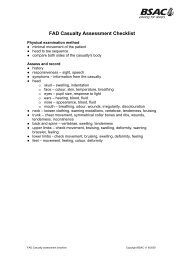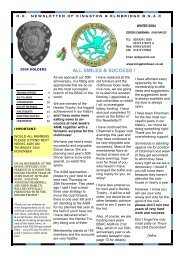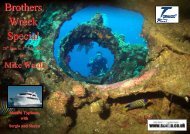At long last!
Download - Kingston & Elmbridge Scuba Diving Club
Download - Kingston & Elmbridge Scuba Diving Club
Create successful ePaper yourself
Turn your PDF publications into a flip-book with our unique Google optimized e-Paper software.
OK - The Kingston & Elmbridge Sub-Aqua Club Newsletter 6Tsunami fundArticle: John Rapley (Chairman)I can confirm that, including a donation from club funds, we have submitteda cheque for £636 to the Disaster Emergency committee fund. We have sincereceived a further £25 making a total donation to date of £661!We have requested a receipt from the DEC, and when this has beenreceived we will post onto the notice-board.The DEC reports that the response from the British public has beentremendous and has now exceeded £250 million. They also assure us thatdonations are being put to good use and are making real differences to thoseat the centre of this disaster.“Rest assured that our member agencies are already operating in theregion with the knowledge that we have a fund that is allowing them to meetpeople’s immediate needs of food, shelter, clothing and water and also <strong>long</strong>ertermneeds. We have already allocated £100 million for their essential work overthe next 12 months.”Nitrox ClubWant to be a member?Article: Alex Morris & Jo-Anne EatonAre you qualified to use Nitrox?If you are, you may be interested in joining the Nitrox Club run bymembers of Kingston & Elmbridge.The club has been running for a couple of years, giving access toextremely cheap fills of nitrox that often cuts the cost of a fill in half.There is an initial joining fee a<strong>long</strong> with a small annual fee. Afterthat the only thing you are paying for is the amount of oxygen you use tofill your cylinders.With the dive season just starting we are now accepting newmembers to this growing club. If you are new to Nitrox or if you are ahardened mixed gas diver this could be of benefit to you.If you are interested in joining and want to know more, pleasedrop Alex a line. You know it's the safe option, so why not find out more.Are you qualified to use Nitrox?Should you wish to become qualified to dive using nitrox, there is acourse taking place on the 18th June.This is a two day course and will qualify you to use up to 50% nitrox asa diving and decompression gas. Minimum grade is a sports diver.________________________________________________________________Further information________________________________________________________________To email Alex: morris.alex@ntlworld.comTo book a course, please use link:http://www.bsac-se.org.uk/Bookingform.asp?EventId=221And to read more about the two day course, see link:http://www.bsac.org/techserv/syllabus/cntrxsyl.htm________________________________________________________________What are you planning?Please email details to ok@grenvillehamlyn.comfor inclusion in a future edition of OK.New advice regardingrate of administrationof Artificial VentilationArticle: Dave Tresidder (South-East Regional Coach)Please find advice below from the NDC regarding new rates for AV. Thisshould be incorporated into all training from now onwards, you may wishto amend your notes and manuals accordingly.Advice regarding rate of administration ofArtificial Ventilation (AV)Land based rescue – The BSAC does not recommend a rate for AV which isapplicable with all casualties in all rescue scenarios. The essential feature ofAV, like all other rescue techniques, is its effectiveness. The effectiveness ofAV is assessed and monitored by observing the casualty's chest rise andfall, the sound of the exhalations, and the ease of inflation of the chest.This allows the rescuer to monitor the degree of inflation provided witheach breath ensuring that that there is neither under- nor over- inflation.The rescuer will also be able to recognise when the casualty's exhalationhas ceased (when the chest has ceasedfalling and the sound of the exhalations has ceased). When thisoccurs it is time to provide another breath to re-inflate the chest. Thismethod automatically sets both the rate of AV and the volume by whichthe chest is inflated, appropriately for the particular casualty?s build. Aslightly built, slim person will therefore be ventilated more shallowly, butat a slightly higher rate, than someone with a larger chest capacity. It is forthis reason no rate is specified.This guidance is in line with that for ?Rescue Breathing? in BasicLife Support (Rescusitation Guidelines 2000; Resuscitation Council (UK)). Insummary these are that only a small amount of resistance to breathingshould be felt during rescue breathing and each rescue breath should take2 seconds, achieving a tidal volume of an amount to produce visible liftingof the chest. The rescuer should then wait for the chest to fall fully duringexpiration before giving another breath. This should normally take about 2- 4 seconds; each sequence of 10 breaths will therefore take about 40 to 60seconds to complete. The exact timing of expiration is not critical; thechest should be allowed to fall before another breath is given.In water rescue – In the water, monitoring effectiveness asdescribed above is almost impossible and other guidance has to be givenby the BSAC. This has to be a compromise because, as noted above, noadvice will be ideal for all casualties and situations. In the water there isalso the possibility that effectiveness may be further compromised by theneed to tow the casualty.The advice of the BSAC is that, in water, ventilations should begiven at a rate of two breaths every 15 seconds. This figure is considered toprovide adequate inflation of the casualty's lungs and adequate deflationbetween the breaths. The inflation phase will take 1.5 to 2 seconds,followed by a deflation (exhalation by the casualty) for about 4 seconds.The total time for the inflation/deflation for each breath of AV willtherefore need to take about 5 - 6 seconds, although again this is anapproximation for an 'average' adult. Once an in-water rescue hasprogressed to the stage where monitoring effectiveness can be performedas for the on land situation described above, that method of monitoringthe effectiveness should take precedence.________________________________________________________________Further information________________________________________________________________http://www.bsac-se.org.uk/Alternatively Dave can be e-mailed at: southeastern.coach@bsac.com________________________________________________________________






